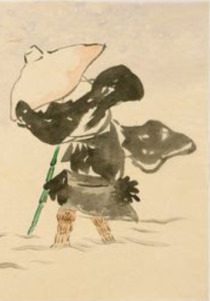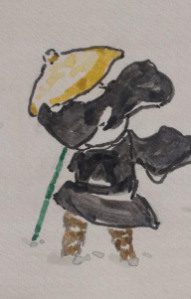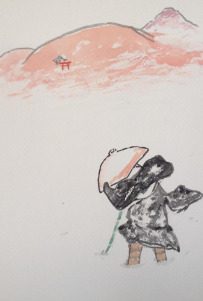Japanese Art by Sawako Utsumi: Buddhism, Shintoism and the Gradual Fading of Kamisaka Sekka
Lee Jay Walker
Modern Tokyo Times
The highly esteemed Kamisaka Sekka (1866-1942) produced stunning pieces of art during rapid changes in the land of the rising sun. These changes in Japan equally apply to times of openness and modernity, to times of socialism and ultimately nationalism. Given this reality, the ebbs and flows of liberalism, socialism, nationalism, tradition, the old world, and modernity, all impacted on this nation during the lifetime of Sekka. Likewise, Sekka focused on the impact of art during the Edo period to looking outwardly towards Western art from the Meiji era onwards. Similarly, Sawako Utsumi is focused on going backwards and forwards and fusing this within a mirage but then moving away from the original influence.
In the original piece by Sekka (below) the theme is a Buddhist monk in difficult weather conditions. Therefore, any interpretation must come from this limited reality. Of course, for Sekka maybe the interpretation is simplistic and not based on any real meaning. Alternatively, maybe Sekka is contemplating something deep but hiding this within simplicity – in truth, only Sekka will know the answer.
However, in the first art piece by Sawako (below) called “Mirage of Sekka” it is clear that admiration and respect is interwoven with love. The theme is simple even if the heartfelt meaning is based on the highest of passions.
The next part in this trilogy (unsure if further expanded) is “Japanese Shrine and Isolated Monk.” This time, Sawako begins to move away from Sekka by focusing on the interplay between Buddhism and Shintoism in Japanese culture. Ironically, just like Sekka resided during the ebbs and flows of change, in Japanese history the same winds of change often went in various directions between Buddhism and Shintoism. Therefore, a connection of chaos and reality is being witnessed through the lens of this art piece.
In the current trilogy – that may be extended in the future – the art piece at the top of this article is titled “Shinto Priest in Search of Buddhist Temple.” By now, the reality of the original by Sekka is fading into a distant memory because now the main character is a Shinto priest. Also, in the last two art pieces mentioned by Sawako it is clear that Buddhism is being highlighted on a much higher stage. Similarly, now Shintoism is powerful and this reality is missing from the original by Sekka because clearly his art piece was based on different meanings – if any meaning existed?
Interestingly, it could be asked why either holy men from the faiths of Buddhism and Shintoism would be in search of holy places that didn’t represent their respective faiths? On top of this, given the harsh conditions, then was this a distant pilgrimage that became fused by the interaction of both faiths – or is this a trick of the artist?
http://fineartamerica.com/profiles/sawako-utsumi.html
http://fineartamerica.com/featured/shinto-priest-in-search-of-buddhist-temple-sawako-utsumi.html
http://fineartamerica.com/featured/japanese-shrine-and-isolated-monk-sawako-utsumi.html
Modern Tokyo News is part of the Modern Tokyo Times group
http://moderntokyotimes.com Modern Tokyo Times – International News and Japan News
http://sawandjay.com Modern Tokyo Times – Fashion
http://moderntokyonews.com Modern Tokyo News – Tokyo News and International News
http://global-security-news.com Global Security News – Geopolitics and Terrorism
PLEASE JOIN ON TWITTER
https://twitter.com/MTT_News Modern Tokyo Times
PLEASE JOIN ON FACEBOOK




